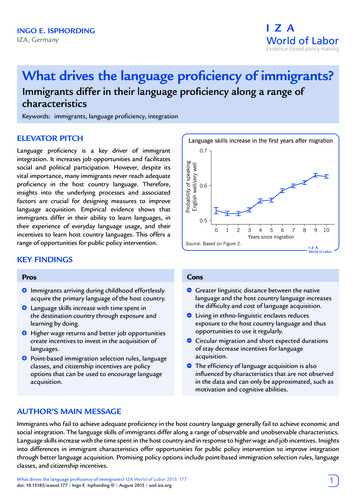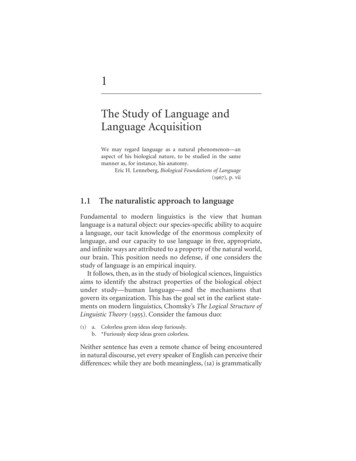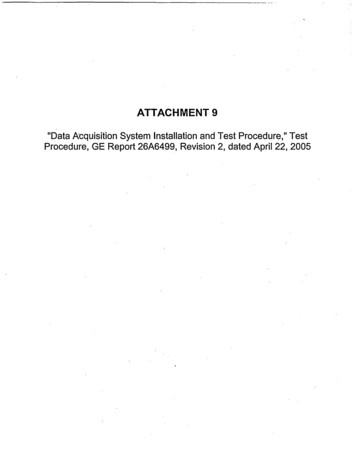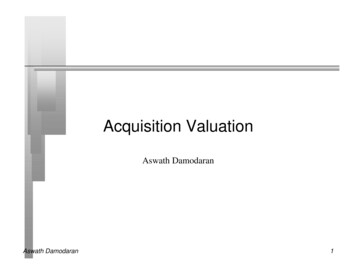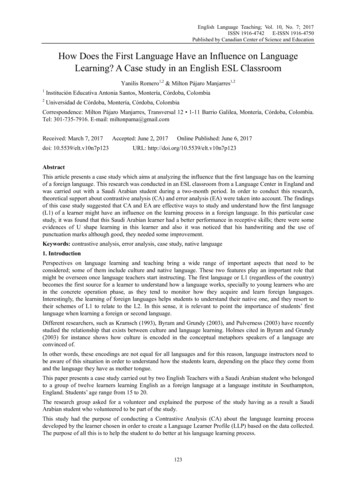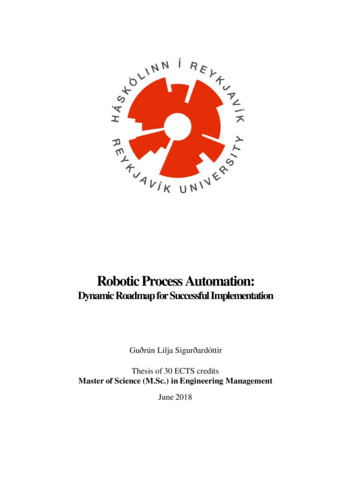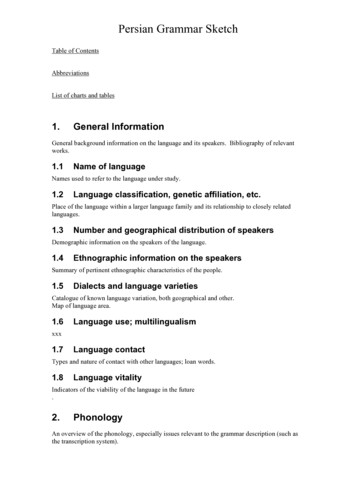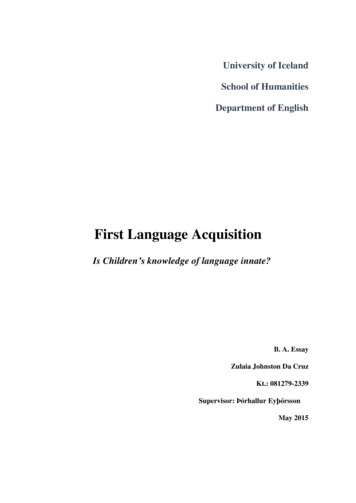
Transcription
University of IcelandSchool of HumanitiesDepartment of EnglishFirst Language AcquisitionIs Children’s knowledge of language innate?B. A. EssayZulaia Johnston Da CruzKt.: 081279-2339Supervisor: Þórhallur EyþórssonMay 2015
AbstractThe aim of this essay is to examine the extent to which children’s language acquisitionis innate. As such, this thesis highlights Noam Chomsky’s Innateness Hypothesis asthe main theory underlying first language acquisition. Chomsky believes that childrenare born with an inherited capacity to learn languages. He points out that there is noway that children could learn language trough imitating adult speech because thespeech they hear is not sufficient to aid children’s acquisition of language. He alsoclaims that the only way to explain how children acquire the complex system oflanguage is if they are born with an innate mechanism which aids the acquisition oflanguage. A language acquisition device called Universal Grammar. UniversalGrammar provides children with universal language principles and its grammaticalstructures.If Chomsky’s hypothesis is correct, then one can expect to find in human biology anddevelopment evidence that reflects specialization for language. Thus, this thesisdiscusses two ways in which humans are specialized for language. First, the thesisdiscusses the brain structure and how certain structures of children’s brains appear tobe specialized for language. Secondly, we discuss the critical period for first languageacquisition and its implications for children’s language acquisition after puberty.Furthermore, the present thesis assesses as well the controversy surroundingChomsky’s hypothesis. Therefore, the criticism and theories of Jean Piaget, MichaelTomasello, Joan Bybee and Hilary Putnam are discussed. First the debate betweenPiaget, and Chomsky is analyzed. Then, Putnam general intelligence debate withChomsky is explained and contested. Finally, the criticism and theory of Tomaselloand Bybee, are considered.The conclusion will demonstrate that despite the criticism there are a variety of studiesthat support Chomsky hypothesis. Therefore, Chomsky’s Innateness Hypothesisremains the leading hypothesis underlying first language acquisition.
Table of Contents1 Introduction . 12 Chomsky’s Innateness Hypothesis . 32.1 Chomsky’s Argument for Innate knowledge of Language . 32.2 Arguments against Chomsky’s Innateness Hypothesis. 73 First Language Acquisition . 93.1 From birth to eighteen months . 113.2 From eighteen months to twenty four months . 123.3 From 24 months to 30 months plus . 133.4 Critical Period for Language Acquisition . 153.5 Is knowledge of language innate or learned? . 184 Conclusion. 22References . 23
First Language Acquisition 11 IntroductionUnlike any other communication system, the human language contains a vocabularyof tens of thousands of words consisting of several dozen speech sounds. A speaker ofany language has the ability to use words and build an infinite amount of phrases whencommunicating with others (Jackendoff 2006, 2). What is most remarkable is thatchildren develop the complex system of language in a matter of two to five years(Jackendoff 1994, 103). For instance, three year old children can build and understandcomplex sentences and master the sound system of their native language without anydirect instruction (O‘Grady 2008, vi). Herein lies the mystery of language acquisition;how is it that children know so much in so little time? To answer that question, thepresent thesis argues how children acquire language based on Noam Chomsky’sinnateness hypothesis. Particularly to question if there is an innate mechanism inchildren’s minds that aids the acquisition of language. Although there are otherreadings on Chomsky’s hypothesis, my focus is on the connection between thedevelopment of certain brain structures and children’s language acquisition. Moreimportantly, my argument is that children’s language development, along with thedevelopment of certain brain structures, seem to demonstrate that children have aninnate ability for language acquisition.Research concerning how children acquire language has been cause for debate,particularly among American psychologists. In 1957, Burrhus Frederick Skinner wroteVerbal Behavior Analysis and suggested that children learn language throughinteraction with the environment (Skinner 1957). These interactions occur throughprinciples of conditioning such as stimulus, association response and reinforcement(Skinner 1957 30, 32). In 1959, Noam Chomsky challenged B.F. Skinner’s theory(Chomsky 1959). Chomsky argued that children could not learn all they needed tolearn about language without having an innate ability to acquire language. Chomsky’sstudies led him to the Innateness Hypothesis a theory that describes how children’sknowledge of language is inborn (as cited by Jackendoff 1994, 35). Since thenlanguage acquisition studies have focused on the psychological part of languagedevelopment and less on social influences.However, the question of how children acquire language is still a subject ofdebate and linguists still argue on how much of language is learned and how much isinnate. Therefore, in order to determine if children’s knowledge of language is innate,
First Language Acquisition 2the following chapters start with a discussion of Chomsky’s Innateness Hypothesis.Next, criticism of Chomsky’s hypothesis is analyzed and scholars such as Jean Piaget(Piaget & Chomsky 2004), Michael Tomasello (2000), Johan Bybee (2010) and HilaryPutnam (as cited by Hakuta 1981) are discussed. Section 3 discusses a wide range ofevidence that supports Chomsky’s theory. First, this thesis presents studies thatdemonstrate the connection between children’s first language acquisition and braindevelopment. Then, the development stages infants go through and the critical periodfor language acquisition are discussed. Afterwards, Chomsky’s theory is summarizedalong with a suggestion of which parts of children’s language acquisition appear to beinnate and which appear to be learned. Section 4 presents the concluding paragraph ofthe present thesis. Consequently, the purpose is to demonstrate that despite criticism,Chomsky’s hypothesis remains the leading hypothesis underlying first languageacquisition.
First Language Acquisition 32 Chomsky’s Innateness Hypothesis2.1 Chomsky’s Argument for Innate knowledge of LanguageChomsky (2004, 17) argues that children’s ability to learn language is due to agenetically programmed organ that is located in the brain. Once children are born andare involved in linguistic environments, they immediately start to develop a language.However, to do that, children must make use of the only tool they have available tothem which is their inborn mental grammar. Chomsky (2004, 17) characterizes thismental grammar as Universal Grammar. Through Universal Grammar, newbornbabies have available to them the grammar of any language existent in the world. Forinstance, the language principles which account for the emergence of English accountas well for Vietnamese, Portuguese, or any other language spoken in the world(McGilvray 2005, 45). After children are born and are exposed to a particularlanguage or languages in the environment, they connect the language to UniversalGrammar and that language becomes the mother tongue. According to Chomsky(2004, 17), the Universal Grammar is available to newborns before their linguisticexperience begins. As such, Universal Grammar is available to children at the initialstate of their language learning.Eventually, the Universal Grammar leads children directly to that whichChomsky (2004) refers to as generative grammar. With generative grammar, childrenunconsciously separate the speech threads they hear around them into grammatical andungrammatical sentences. Furthermore, with generative grammar, children will alsodevelop the ability to understand structure and create infinite new languageexpressions. When children have reached the full potential of their generativegrammar, they have reached full knowledge of language and are able to use languagefluently (Chomsky 2004, 19). Therefore, the acquisition of language is not a passiveact by which children simply soak up information they hear in the environment. It isan active act by which children construct unconscious principles that permit them toreceive information, produce novel utterances, and use language in a variety of forms(Jackendoff 1994, 35).Consequently, as far as language grammar goes, children have their owngrammar and follow it until they have adjusted it into adult grammar. As Chomsky(1965, 58) suggests, children’s language mastery involves an inborn knowledge ofgrammar and grammatical rules. Even though children make grammatical errors when
First Language Acquisition 4they are learning their first language, they rapidly master the complex system oflanguage on their own and without the use of parental instruction. A good example ofthat is provided to us by the psychologist Martin Braine; after spending some timetrying to correct his daughter’s grammatical errors, the following happened (as citedby Pinker 1994, 281),Child: Want other one spoon, Daddy.Father: You mean, you want the other spoon.Child: Yes, I want other one spoon, please, Daddy.Father: Can you say the other spoon?Child: Other .one spoonFather: Say .otherChild: OtherFather: SpoonChild: SpoonFather: Other SpoonChild: Other .Spoon. Now give me other one spoon?As presented in the example above, even though parents might attempt to correct theirchild’s grammatical errors, the correction has little to no effect. First reason being thatthe correction is neither done frequently enough, nor effective enough, to have thenecessary impact (O‘Grady 2008, 169). Secondly, because children do not hear theirown errors and are liable to ignore or resist correction when it takes place (Jackendoff1994, 105). Therefore, the language errors children make are not really errors, butrather a necessary part of their language acquisition process.Furthermore, children’s use of ungrammatical language reflects their attemptto construct the grammar rules of language on their own. Also, it reflects thatchildren’s language acquisition does not derive directly from the information that
First Language Acquisition 5comes from the environment (McGilray 2005, 50; Jackendoff 1994, 35). Asimpressive as it may seem, children alone develop their own strategies for learninglanguage. For instance, when children reach the ages of twelve to eighteen months, agrammar emerges in their language. Once that happens, children rapidly and withoutassistance acquire most of the syntactic structures and grammatical rules of theirlanguage (O’Grady. et al. 1997, 476). Undoubtedly, the input that children receivefrom the environment plays a role in the acquisition of language, however, children donot learn through parental instruction or imitating what they hear. Depending on eachchild, the process of imitation only occurs 5 to 40 percent during conversation withadults (O’Grady 2008, 175). Consequently, it appears that language acquisition cannotbe interpreted as a recapitulation of adult language, but rather a demonstration ofchildren’s creative and resourceful mind.Even if children could attempt to imitate adult’s speech they would end up withinadequate language, because the language children hear around them is insufficient.In other words, there is no way adults could possibly present children with all lexical(verbal) items that exist in their language (on average 50,000-250,000 words) (Lust2006, 28). Furthermore, the speech provided by adults is not always grammaticallycorrect (Lust 2006, 29). A study conducted by Trott, Dobbinson, Griffiths (2004, 5)suggests that when adults speak to children, they change their speech register and usesimplified grammar. This simplified speech is used by caregivers, parents, or oldersiblings and is called child direct speech (CDS). Although Trott et al. suggest that theuse of such speech might help children’s language learning that is not always the case.Studies conducted by Stephen Crain and Diane Lillo-Martin (1987, 14) suggest thatwhen adults use CDS they might deprive children from hearing full grammaticallanguage. As a result, adults’ use of CDS can make it difficult for children to learnfrom expressions produced by adults. Children can, however, learn some aspects oflinguistic organization from hearing adults speak, for example, though matching wordswith meanings and thereby acquiring the vocabulary of their language (O’Grady. et al.1997, 483).Therefore, for language acquisition to take place, children need have availableto them something more than just the input they receive from the environment or adultinput. Children might learn language from hearing others speak around them,nonetheless the knowledge of language they end with is far more complicated thanwhat is available to them in the environment. So to understand how children’s first
First Language Acquisition 6language acquisition happens, we must look inside the child and beyond outsideinfluence. In a scientific sense, language does not develop in the outside world, butrather in the minds of children, therefore there is no learning in the traditional sense(Lenneberg 2002, 6). In fact, children’s language acquisition differs a great deal fromthe kind of formal learning that takes part in schools or psychologist laboratories.When children are about one-year-old, or sometimes before, they will say their firstwords. By the age of five, every child has already managed to acquire language, andspeaks it fluently. All of that happens before children start formal language learning(Sigurjónsdóttir 2013).Although children have the natural ability to learn language and do it withoutformal instructions, children do not learn language based on general intelligence,either. Studies show that children who have a low IQ or are born with some mentaldelay learn language just as well as any other child. As Steven Pinker (1995) explains,Hydrociphalic children occasionally end up mentally underdeveloped due to largecavities of the brain affected by malformation; however, they can take part in fullyarticulated and fully grammatical conversations. Furthermore, children who are bornwith William Syndrome, an inborn condition involving physical abnormalities andmental delays, grow up to have fully articulated language abilities (Pinker 1995).These cases demonstrate that children do not depend on general intelligence to acquirelanguage and have fluent, articulated language abilities.In conclusion, the claim Chomsky is making is that even though children makegrammar mistakes and are not exposed to enough linguistic input, children manage toacquire the complex system of language very rapidly. Furthermore, children acquirelanguage without parental assistance and without the use of general intelligence. ForChomsky, the only way to explain how children acquire the complex system oflanguage is if they are born with an innate ability to acquire language. Consequently,Chomsky created the Innateness Hypotheses and suggests that children are born witha mental grammar that produces knowledge of language, given that there is presentexperience. So without having an inborn Universal Grammar, children’s languageacquisition process would be more complicated and probably take a longer time.Conversely, with Universal Grammar, all children are rapidly able to acquire language,except under extreme conditions (which will be discussed in chapter 3.4). AlthoughChomsky’s hypothesis has revolutionized modern linguistics and brought great
First Language Acquisition 7changes to the study of language acquisition, the basis for this human ability is stillcause for debate.2.2 Arguments against Chomsky’s Innateness HypothesisEver since Chomsky put forward his Innateness Hypothesis, his theory has been thetarget of significant controversy. Initially, when Chomsky challenged B.F. Skinner’sVerbal Behavior, he had a great impact on research developments and attitudestowards language acquisition studies. Even Skinner himself found it difficult to answerChomsky’s criticism. Skinner considered Chomsky’s review emotional and claimedthat it lacked knowledge of behaviorist studies (as cited by Virués 2006). As reportedby Virués Ortega (2006), Skinner briefly mentioned Chomsky’s review in a lecture in1972, however, Chomsky never formulated a response to Skinner’s criticism. Aftereight years passed criticism towards Chomsky’s theory started to surface (Virués2006). Eventually, Chomsky encountered his first serious opponent: Jean Piaget; thetwo engaged in a debate regarding the nucleus.Chomsky and Piaget (Piaget & Chomsky 2004) are both nativists and believethat children’s language ability derives from inherited genetics. The main point ofdisagreement between them are the specific aspects (which in their debate they calledthe nucleus) of children cognition that are responsible for language acquisition. Piaget(Piaget & Chomsky 2004, 69-70), does not agree that children’s language ability isconstrained by a fixed nucleus (Universal Grammar). Piaget’s (Piaget & Chomsky2004, 65-66) comprehension of language development lies in the very process of itstransformation. He believes that children knowledge of language happens alongsidewith logical thinking and reasoning. So when Piaget (Piaget & Chomsky 2004) refersto this genetic nucleus, he sees it in constant mutation that is directly connected withchildren’s construction of knowledge due to experience with the outside world. Tohim, children’s language knowledge is subject to changes and growth that increase dueto children’s understanding or assimilation of the world. Therefore, Piaget (Piaget &Chomsky 2004) believes that children’s language development occurs simultaneouslywith their logical thinking and refuses to accept Chomsky’s idea of a fixed nucleus.Chomsky (Piaget & Chomsky 2004), on the other hand, describes cognitivedevelopment as the consecutive maturation of Universal Grammar (fixed nucleus). Inhis response to Piaget’s criticism, Chomsky argues that there is no relevant experiencethat leads to the construction of linguistic knowledge. Chomsky (as cited by Hakuta
First Language Acquisition 81981) disagrees with Piaget’s views and debates that language knowledge must bepresent in children’s minds when they are born for language acquisition to take place.This language knowledge is triggered by language experience and from input from theenvironment.In resume, the debate between Piaget and Chomsky resulted in a tensionrelating to development hypotheses of children’s language knowledge. For Piaget(Piaget & Chomsky 2004) the explanation to how children acquire language lies inexperience and assimilation. While for Chomsky (Piaget & Chomsky 2004), theexplanation lies on children’s innate abilities. After analyzing both Piaget andChomsky views, it seems that their arguments are not so different because they bothgive a central role to internal activities that happen in the child’s brain.Aside from Chomsky’s and Piaget’s central tensions, there are other scholarsthat oppose Chomsky’s Innateness Hypothesis. Hilary Putnam (as cited by Hakuta1981), engaged in a debate with Chomsky and Jerry Fodor (as cited by Hakuta 1981)regarding the concept of nativism. In their argument, Hilary Putnam (as cited byHakuta 1981) suggested that innateness was part of general intelligence instead ofbeing part of an innate mechanism. Although Putnam (as cited by Hakuta 1981) poseda plausible remark, research points to a disassociation between intelligence andlanguage acquisition. As already noted, studies of people who have William Syndromeshow that even though these individuals have an IQ of 50 and are inept in everydaytasks, they have fluent and articulated language abilities (Pinker 1995). Therefore,language is not a capacity that is based on general intelligence, but rather an internalactivity that can be explained it terms of innate abilities that every child possesses.Another linguist that rejects Chomsky’s theory is Michael Tomasello (2000,156), he argues that children imitatively learn language. He believes that children hearthe language speech that is used around them, then use their social skills toprogressively start to categorize, put in schemas, and creatively combine individuallylearned expressions. Therefore, children use language to acquire knowledge oflanguage. In other words, children’s language use helps them create languageknowledge.The key notion of Tomasello’s (2000) theory is the term construction; heexplains that the grammar of a language is a repertory of construction instead ofgenerative as outlined by Chomsky. During an experimental research study, Tomasello(2000, 157) observed that children’s initial stages of linguistic competence are not
First Language Acquisition 9categorized as grammar, but rather as items based formula called Verb IslandHypothesis. Tomasello therefore suggests that children take novel verbs and each verbforms its own island and construct the grammar of their native language.Joan Bybee (2010) further developed Tomasello’s (2000) theory by suggesting thatwhen children acquire language, they do it in a bottom up manner. The term bottomup is defined as the notion that language acquisition starts first with languageperformance and later children construct language competence. In other words, fromlanguage usage comes language knowledge and the capacity to produce language.According to Bybee (2010, 18), children’s system of grammar is not self-containedor stagnant, but is subject to change and motivated by language use. Furthermore,Bybee (2010, 18) suggests that a child’s linguistic experience grows with interactionand exposure to language. The repeated routine of listening and speaking facilitateslanguage processing. Therefore, children’s competence of language is regularlyupdated and stored in their brains. In conclusion, while Chomsky claims thatlanguage grammar is inside of the child’s brain, Tomasello (2000) and Bybee (2010)suggest that grammar is a construct of language usage, therefore it happens due tooutside experience.In summary, the critics against Chomsky’s hypothesis dwell on the nature ofUniversal Grammar and question its existence. Despite being the target of criticism,Chomsky found supporters among biologists and neurobiologists alike. As revealed inthe next chapters, there are studies that support Chomsky’s Innateness Hypothesis andthe existence of an inborn mechanism that aids first language acquisition.3 First Language AcquisitionChildren’s language acquisition is considered to start when children say their firstwords. However, children already show that they have communication abilities whenthey are born. According to Boysson-Bardies (1999, 29), most babies of four monthsof age act in response to their name without realizing that the sound forms havereferential function. That observation indicates that babies have good perception ofsound. It also indicates that the brain of the newborn baby is more developed than iscommonly expected at the initial state.If the newborn baby’s brain possesses an innate disposition for language,behavior correlations with this genetic specification must exist. In 1971, Peter Eimas,
First Language Acquisition 10E Siqueland, P. Jusczyk, and J. Vigorito (as cited by Boysson-Bardies 1999, 20-21)made use of the only behavior mastered by newborns (sucking) to carry outexperimental research on their previous knowledge of language. They measured thesucking rate of four-month old babies to see if they could distinguish between speechsounds categorically. The experiment was conducted as follows (as cited by BoyssonBardies 1999, 20-21),First the babies were put in carriers and then they were given electronic rubbernipples that were connected to a computer. The objective was to measure the babiessucking rate and from it test if they could perceive the difference between twoconsonants [a] and [b]. The babies revealed interest to the sounds they heard bysucking vigorously than their sucking diminished. The resumption of sucking as aresult of change of stimulus indicated that the babies had perceived the differencebetween the two consonants. Later studies conducted in the same form also show thatbabies as young as three and four days old are capable of differentiating almost allphonetic contrast found across natural languages. Therefore, newborn babies candiscriminate between the contrast of voicing, place and manner of articulation. Thatshows that even before infants start to use language, their brain already shows an innatedisposition for language.According to Broca and Carl Wernicke (as cited by Boysson-Bardies 1999,29), there are two areas responsible for comprehension and production of language inthe brain. The left hemisphere’s fundamental function is to process rapid acousticalchanges and speech sounds. In contrast, the right hemisphere is responsible forperception of acoustic sounds distributed over a long period of time and controlsprosody. Prosody is stress, rhythm and intonation, all elements that are particularlyimportant for speech. In addition, the right hemisphere matures faster than the lefthemisphere before and after birth. Consequently, that explains why babies are attentiveto sounds and vocalize before they articulate. That also explains that languageacquisition and brain lateralization develop at a complementary rate.Since infants are born with the right hemisphere more developed than the lefthemisphere, they cannot talk at birth. They can only recognize intonations and speechsounds. The left lateralization plays a primary role in language (Boysson-Bardies1999, 31). Therefore, damage to the left hemisphere can provoke aphasia, adysfunction or loss of language due to neurological damage (Lust 2006, 77). Furtherobservations into brain development and language acquisition show that children who
First Language Acquisition 11suffer from brain damage (or are victims of prenatal injury or disease) requiring lefthemisphere removal will acquire the ability to speak. Nevertheless, the removal of theleft hemisphere has to occur before they are one year old for the recuperation to betotal (Boysson-Bardies 1999, 31).It seems that the development of the left hemisphere and the right hemisphereappear to be in tune with the language developments of children. Additionally, thediscrepancy between maturation rhythms of the two hemispheres in the first years,explains certain characteristics of language development, such as the form in whichwords are first coded (Boysson-Bardies 1999, 29). In resume, children’s initial processof language acquisition starts with attention to the intonation patterns of language.That means that their attention to language sounds develops in advance from languageproduction. That also means that at an initial state, the brain of a newborn is far frombeing empty and presents signs of having Universal Grammar that helps the childdistinguish the sounds of language.3.1 From birth to eighteen monthsChildren’s language development follows predictable milestones and the foundationsof the development are inborn and genetically coded. As mentioned previously, beforebirth, infants develop brain lateralization that aids in the recognition of intonation oflanguage. After birth, babies start babbling with no particular linguistic intention. Aftera couple of months, the babbling strings of babies begin to be uttered with intonationpatterns. Eventually, the baby language gradually starts to tune in to the language inthe environment. According to Jackendoff (1994, 62), when learning a language, thechild selects certain speech sounds from the ones available in the universal grammarto match those in the environment. The child selects the sounds correspondent tohis/her native language and unconsciously knows how to sort them out. Subsequently,important milestones are reached in a fixed sequence and in a relative constantchronological age.When children reach twelve to eighteen months of age, they start to produceone-word utterances. This stage is called holophrastic stage (O’Grady. et al. 1997,476). The first words children utter are identical universally across cultures and theyare in most cases mommy and/or daddy. Other words in their vocabulary include nameslike, dada, mommy, and Cindy (or any other name); object words like spoon and car;pointing words like that; action words like eat and push; properties like hot; directions
First Language Acquisition 12such as up, down and no; greetings like bye (Jackendoff 1994, 103). Thus, the majorityof children’s one-word vocabulary consist of noun-like words, whereas verb-likewords are not so common. Their one-word vocabulary may also contain animalsounds, references such as meow, or sound references to objects such as Choo-Choofor train (Gleason, & Ratne 1993, 314 - 315). Furthermore, children may use the wordmommy to say I see
First Language Acquisition 3 2 Chomsky’s Innateness Hypothesis 2.1 Chomsky’s Argument for Innate knowledge of Language Chomsky (2004, 17) argues that children’s ability to learn language is due to a g
